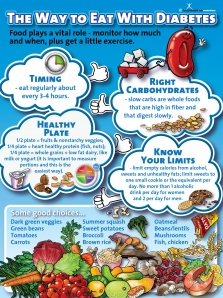Eat Well with Diabetes
 Scheduling MealsMaintaining regular blood glucose levels is key to life with diabetes. You can keep those levels in check by sticking to a regular schedule of healthful meals and snacks. A popular meal schedule includes healthful snacks between breakfast, lunch, and dinner. ALWAYS eat breakfast.Healthful Food OptionsBe sure to consume a variety of healthful foods in moderation. Great choices include whole grains, complex carbohydrates, lean protein, low-fat dairy, fruits, vegetables, and healthful fats. Steer clear of trans fats, saturated fats, sugar, and processed foods. If you must indulge occasionally, stick to small portions.Benefits of Whole Grains and Complex CarbohydratesWhole grains and complex carbohydrates are great sources of quick, long-lasting energy. They’re also excellent sources of fiber, vitamins, and minerals, all of which help keep you healthy.Benefits of Lean Protein and Low-fat DairyLean protein and low-fat dairy also provide important vitamins, minerals, and energy. LEAN and LOW-FAT are the operative words in those descriptions – as fat increases, so do the drawbacks and health risks. Did you know that cheese is the biggest source of fat in the American diet? Stick to low or reduced-fat options. Keep your portion sizes small – meals don’t need to revolve around these two elements.Benefits of Fruits and VegetablesEndless. We’re only sort of kidding here – whole fruits and vegetables are extremely good for you. Only 23% of American adults get at least 5 servings of fruits and vegetables per day. Join that club and bring those numbers up! Fruits and vegetables are fantastic sources of fiber, vitamins, and minerals, not to mention their role as amazing low-calorie energy providers.By Victoria Shanta Retelny, RD.
Scheduling MealsMaintaining regular blood glucose levels is key to life with diabetes. You can keep those levels in check by sticking to a regular schedule of healthful meals and snacks. A popular meal schedule includes healthful snacks between breakfast, lunch, and dinner. ALWAYS eat breakfast.Healthful Food OptionsBe sure to consume a variety of healthful foods in moderation. Great choices include whole grains, complex carbohydrates, lean protein, low-fat dairy, fruits, vegetables, and healthful fats. Steer clear of trans fats, saturated fats, sugar, and processed foods. If you must indulge occasionally, stick to small portions.Benefits of Whole Grains and Complex CarbohydratesWhole grains and complex carbohydrates are great sources of quick, long-lasting energy. They’re also excellent sources of fiber, vitamins, and minerals, all of which help keep you healthy.Benefits of Lean Protein and Low-fat DairyLean protein and low-fat dairy also provide important vitamins, minerals, and energy. LEAN and LOW-FAT are the operative words in those descriptions – as fat increases, so do the drawbacks and health risks. Did you know that cheese is the biggest source of fat in the American diet? Stick to low or reduced-fat options. Keep your portion sizes small – meals don’t need to revolve around these two elements.Benefits of Fruits and VegetablesEndless. We’re only sort of kidding here – whole fruits and vegetables are extremely good for you. Only 23% of American adults get at least 5 servings of fruits and vegetables per day. Join that club and bring those numbers up! Fruits and vegetables are fantastic sources of fiber, vitamins, and minerals, not to mention their role as amazing low-calorie energy providers.By Victoria Shanta Retelny, RD.


